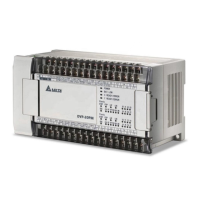5 Applied Instructions and Basic Usage
Example 2
States of devices
Device
States of contacts
before the execution
of CJ
States of contacts
during the execution
of CJ
States of output coils
during the execution
of CJ
M1, M2, and M3 are
OFF.
M1, M2, and M3 are
turned from OFF to
ON.
Y1
*1
, M20, and S1 are
OFF.
Y devices,
M devices,
S devices
M1, M2, and M3 are
ON.
M1, M2, and M3 are
turned from ON to
OFF.
Y1
*1
, M20, and S1 are
ON.
M4 is OFF.
M4 is turned from
OFF to ON.
The timer T0 does not
count.
M4 is ON.
M4 is turned from ON
to OFF.
The timer T0 stops
counting immediately.
When M0 is turned from
ON to OFF, the timer T0
is reset to 0.
M6 is OFF.
M6 is turned from
OFF to ON.
The timer T240 does
not count.
10
millisecond
timers
M6 is ON.
M6 is turned from ON
to OFF.
The timer T240 stops
counting immediately.
When M0 is turned from
ON to OFF, the timer
T240 is reset to 0.
M7 and M10 are OFF. M10 is ON/OFF.
The counter C0 does
not count.
C0~C234
M7 is OFF. M10 is
ON/OFF.
M10 is ON/OFF.
C0 stops counting. After
M0 is turned OFF, C0
will resume counting.
M11 OFF
M11 is turned from
OFF to ON.
The applied instructions
are not executed.
Applied
instructions
M11 ON
M11 is turned from
ON to OFF.
The applied instructions
which are skipped are
not executed, but API
53~API 59 and API
157~API 159 are still
executed,
*1: Y1 is a dual output. When M0 is OFF, Y1 is controlled by M1. When M0 is
ON, Y1 is controlled by M12.
DVP-20PM Application Manual
5-15

